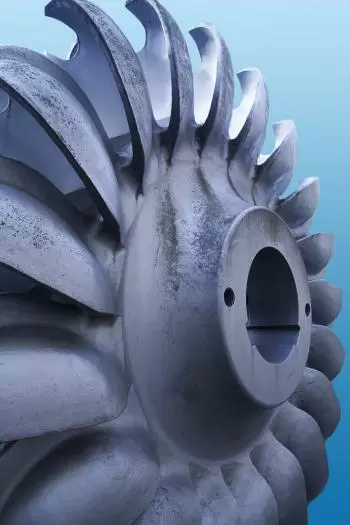
A Pelton turbine is a hydraulic turbine used in hydroelectric power plants with high vertical height. It is also called Pelton wheel turbine and belongs to the impulse turbine group.
It was invented by the American engineer Lester Allan Pelton in the 1870s and significantly improved by other inventors beyond the late 1800s.
The objective of this turbine is the transformation of the hydraulic energy in the impulse of one or more jets of water at a very high speed to mechanical energy generating electricity.
A Pelton turbine is 92% efficient in harnessing hydraulic energy.
How does a Pelton turbine work?
The Pelton turbine is generally installed in a hydroelectric plant and connected to a pressure pipe from a high-rise dam.
The potential energy of water accumulated at high altitudes reaches the turbine through "forced ducts" (large pipes) that lead the water downstream. A nozzle (or more than one) directs the water onto the Pelton blades. The water jet strikes the buckets causing the turbine and shaft to rotate.
Thanks to its shape, the nozzle transforms into kinetic energy all the pressure contained in the ducts, so the jet on the turbine will not be under pressure: for this reason, the Pelton turbine is an action turbine.
The turbine shaft is connected to a generator that produces electrical energy.
Pelton designed the blades so that the water jet rotates almost 180 ° after leaving the blades. The water leaves the turbine wheel at a light speed.
Fluid mechanics features
The maximum thrust occurs when it is stationary when the difference between the speed of the jet and the impeller is more remarkable. Therefore a positive characteristic of this type of turbine is to have a very short starting transient.
The flow rate of the jet can be adjusted, reducing the section without negatively affecting the efficiency of the energy transformation. Another helpful tool in regulation is the diverter plate which intercepts part of the flow coming out of the nozzle diverting it.
The jumps on which Pelton turbines are used generally range from 1,400 m up to even 300 m. As the leap decreases, there is a greater catchment area going down to the valley with consequent more demanding flow rates. To cope with this phenomenon, it is necessary to use Pelton with larger spoons to divide the flow of water into several equal parts to have the Pelton poly-jet.
An intrinsic defect of this turbine is that it cannot use the entire height of the head since the impeller, not being able to be immersed in the discharge channel. The drawback is the more negligible, the higher the water jump is.
Pelton turbine parts
The main components of the Pelton turbine consist of:
-
A pipe called a pressure gallery to transport the water to the turbine from great heights.
-
Nozzle and flow regulation arrangement to accelerate inflow rate.
-
Rotor and blades are responsible for converting the force of water into mechanical energy.
-
The housing is where the rotor is housed. It is filled with air with atmospheric pressure.
-
The braking jet is used to stop the runner wheel.
The rotor
The rotor is a circular disc that can be mounted on a vertical shaft or a horizontal shaft and is equipped with one or more bearings. Typically horizontal axes are used for hydro turbines with one or two jets of water, while one selects the vertical axis if there are more water jets.
The nozzle or nozzles on the Pelton turbine are mounted so that the water jet hits the outermost blades on the impeller at right angles.
The blades
The blades are mounted in the shape of bowls so that the water jet touches each blade instantly. Because the water has a certain velocity after it has left the containers, it quickly disappears from the impeller. In this way, the containers are empty of water when they reach the following stream of water.
The blades are double to cut the water jet in the middle. Each of the two halves of the container deflects half of the stream of water. The water, having to follow the containers’ contour, makes a "U-turn.” Each half of the split water jet passes virtually a 180 ° bend before leaving the outer edge of the container.
This division balances the lateral loading forces on the wheel and axle. The fact that the water makes a "U-turn" is a prerequisite for the best possible utilization of the momentum of the water jet.
Deflectors are often used along with the spear valve to prevent the severe water hammer problem due to a sudden reduction in the rate of flow.
A small part of the original kinetic energy in the water flow remains in the water after the wheel has turned to the next bowl. It is necessary so that the water runs out of the impeller quickly and to avoid collision between the water and the back of the bowls.
For what is the Pelton turbine used?
The Pelton turbine is the preferred type of turbine for waterfalls with high heads and with small amounts of water.
Often the turbines used in small power plants, mini-hydropower plants, and hydroelectric plants are Pelton turbines.